Tales From Windy City Pulp and Paper
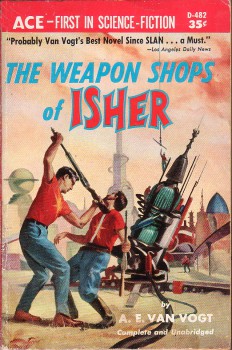 This coming weekend, Friday April 25th through Sunday April 27th, is Doug Ellis’s magnificent celebration of all things pulp, the Windy City Pulp and Paperback Convention here in Chicago, in nearby Lombard, Illinois.
This coming weekend, Friday April 25th through Sunday April 27th, is Doug Ellis’s magnificent celebration of all things pulp, the Windy City Pulp and Paperback Convention here in Chicago, in nearby Lombard, Illinois.
Windy City is one of my favorite local cons. I’ve written about it before, and in fact I’ve been attending the show for around 10 years. 2012 was perhaps the most successful show in some years, considering I returned with a fabulous assortment of mint-condition fantasy and science fiction paperbacks from the collection of Martin H. Greenberg. See the article and photos from that show in my 2012 post, “Thank You, Martin H. Greenberg (and Doug Ellis).”
The show has been growing steadily over the years. Doug and his cohorts have added a film program, an Art Show, panels, an auction, readings, and more programming, but the real draw continues to be the massive Dealer’s Room, a wall-to-wall market crammed with pulps, paperbacks, rare DVDs, posters, artwork, comics, and much more.
I jotted down a few notes last year, and promised myself I’d write them up before the 2014 convention, to let folks who may be on the fence about attending (or those sad and lonely souls who, like me, just enjoy reading far-off convention reports), know what they’re missing.
In 2013, the list of Dealers was the longest I’ve ever seen, boasting some 80 vendors. They had to add more space, and it took even longer to walk the floor. Doug reported that he sold more tables than at any previous convention, and in record time.
If there’s a drawback to the show, it’s that the Dealer’s room closes at 5:00 pm. That made it impossible for me to make it there after work on Friday. My weekly D&D game with my kids kept me tied up until after 3:00 pm Saturday, which meant that by the time I made the show on Saturday, I had less than half an hour to walk the floor before it closed.
I put the time to good use. After a few years, you tend to find a few favorite sellers and I searched them out immediately.
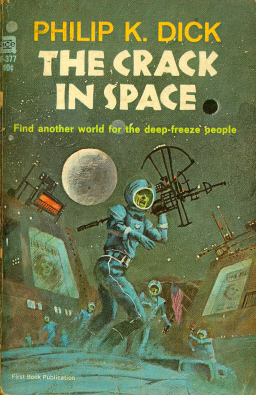 [Click on any of the images in this article for larger versions.]
[Click on any of the images in this article for larger versions.]
The first seller I found was John Hauser, who’s sold me hundreds of top-quality vintage SF digests over the years. I first met John when I negotiated to buy virtually his entire stock six years ago, and something like that sticks with you.
Sadly, by the time I found John he’d sold off almost everything on his table.
“Where were you?” he asked. It’s moment like this that make you wish you didn’t have to work for a living.
Fortunately, John still had a small assortment of choice paperbacks in great condition left on his table, and he made me a sweet deal.
I ended up purchasing Philip K. Dick’s A Crack in Space, Edmond Hamilton’s Crashing Sons, Ace Double D-53 (including A. E. van Vogt’s The Weapon Shops of Isher), Asimov’s The Martian Way, and several other digests and paperbacks from the 60s and 70s, all for under $2 each.
John also gave me a box to carry all my treasures in, which would cause me unexpected anxiety. But more on that later.
My next stop was Bill Maynard’s table. I met Bill for the first time at Windy City 2012, and I found him a fascinating guy with an almost encyclopedic knowledge of pulp history — and world history in general. He blogs for Black Gate every Friday, under the name William Patrick Maynard.
We hit it off immediately, and last year I purchased a copy of his novel The Destiny of Fu Manchu (which we reviewed here), the sequel to his first Fu Manchu novel, The Terror of Fu Manchu.
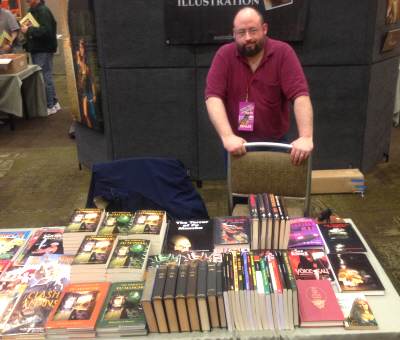
It was great to re-connect with Bill. He told me about his new job as a technical writer in the oil fields of Alberta, which takes him out of the country three weeks out of every month. Talk about a life of adventure!
But the most interesting thing I learned from Bill was that he had a reading on Sunday morning — part of the New Pulp Sunday reading series the con had put together.
I really didn’t want to miss that. In fact the whole reading series, which focused on some of the best talent writing pulp fiction today, looked great. A partial list of the participants in the con program included David C. Smith, Ron Fortier, Chris Bell, Joe Bonadonna, David White, and many others.
The online description, which I only found after the convention was over (isn’t that always the way?), is here.
Windy City put up a gorgeous ad promoting the event, with just a sample of the books that would be read from on Sunday. Hard to imagine a better way to spend a lazy Sunday afternoon, in my book.
I marked my program, and made sure I knew where the reading room was.
Sometimes it seems like all you have to do is say someone’s name at Windy City Pulp, and they show up at your side. No sooner had I noticed Joe Bonadonna’s name in the list of Sunday readers than he wandered by as I was speaking with Bill.
Joe’s latest book — Waters of Darkness, co-written with David C. Smith — has proven extremely popular. In fact, the announcement we made on the BG blog was the single most popular post for March 2012, and the excerpt we published quickly climbed to the #2 fiction slot for the month. For most of 2013 Waters of Darkness was at or near the top of the most popular fiction links at Black Gate — up against some pretty stiff competition, I might add.
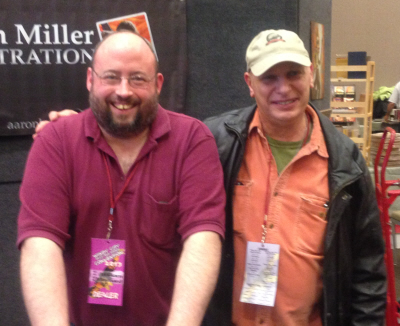
I didn’t waste an opportunity like this, and snapped a pic of Bill and Joe together in Bill’s booth. That’s it at right (click for a bigger version).
To my surprise, Joe presented me with a copy Waters of Darkness. I flipped it open and found it was inscribed by both he and Dave Smith, and I was touched and honored.
I also noticed the book was dedicated to Morgan Holmes and Christopher Heath (author of the Azieran books).
You can’t stand still at Windy City Pulp & Paper for more than a minute without running into someone in the industry, and that’s exactly what happened as I talked with Bill and Joe. Author and artist Bill “Indy” Cavalier wandered by, and before long all four of us were happily chatting.
Indy gave me a copy of the latest Robert E. Howard Foundation Newsletter. I’d never seen one before, and it was a beautiful piece of work.
“Every issue contains an original work or contribution from Robert E. Howard,” Indy told me proudly.
He had a right to be proud. The newsletter was gorgeous, sharply designed and with slick pages. This issue’s original contribution was a 2-page photocopied letter from REH to “Editor of Weird Tales“ and a poem, “Whence cometh Erlik?”
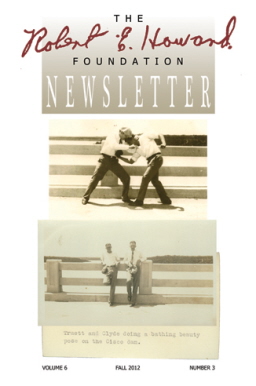 While I glanced through the issue, Indy reminded me that he was trying and recruit me to join the REH Foundation. It was a genuine honor to be invited, but just the thought of another commitment scares me at this point.
While I glanced through the issue, Indy reminded me that he was trying and recruit me to join the REH Foundation. It was a genuine honor to be invited, but just the thought of another commitment scares me at this point.
Morgan Holmes wandered by a few minutes later — yes, the same Morgan Holmes whose name I had just read in the dedication page for Waters of Darkness.
See what I mean about mentioning someone’s name and they show up?
I shook Morgan’s hand, and he said the seven words I never expected to hear: “You need more Theo on the blog.”
If you didn’t follow the drama surrounding Theo Beale’s run against Steven Gould for President of the Science Fiction Writers of America (or his subsequent expulsion from SFWA), I won’t bore you with the details. Suffice it to say that, typical for Theo, both events created a storm of controversy.
Theo left the Black Gate blog two years ago, but I still get the occasional colorful piece of hate mail from his detractors.
He apparently still has a few supporters however, and Morgan was obviously one.
While we chatted Morgan saw the Newsletter in my hands, and casually mentioned that Indy destroys all the undistributed REH Foundation Newsletters at the end of the year — which made me especially happy I got one. Seemed an odd thing to do, but I’m sure there’s a good reason for it.
Eventually, the newsletter went into the top of the box. Remember the box? It’ll become important in a moment.
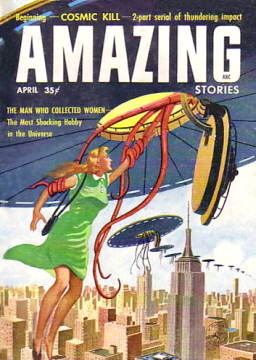 Across from Bill was a seller with several long boxes of vintage SF and fantasy digests under his table. I was inexorably drawn to them. One of the first magazines I picked up was the April 1957 issue of Amazing Stories, with a classic Edward Valigursky cover of a fleet of flying saucers over Manhattan, and a woman being sucked up by a host of squirming red tentacles.
Across from Bill was a seller with several long boxes of vintage SF and fantasy digests under his table. I was inexorably drawn to them. One of the first magazines I picked up was the April 1957 issue of Amazing Stories, with a classic Edward Valigursky cover of a fleet of flying saucers over Manhattan, and a woman being sucked up by a host of squirming red tentacles.
She looked remarkably poised for a woman being abducted by red tentacles, but maybe this kind of thing happened all the time in the 50s. I dunno.
The magazines turned out to be a mixed lot — Analog, Fantasy & Science Fiction, Amazing, Galaxy, and Fantastic, all from the 1950s through the 1970s. Some of them were a little rough, but most were in great shape, with no mailing labels .
I have a real weakness for vintage SF digests. They were the first things I ever really collected — if you don’t count comics — and unlike, say, pulps, for the most part the market remains fairly soft, meaning you can purchase them for a very reasonable price.
Case in point. I ended up making a deal with the seller on Sunday, purchasing over 200 vintage digests for $100 — under 50 cents each! It took some negotiating, but I got to select the ones I wanted from his huge collection.
Nearly a year later, they’re still sitting in two boxes in my living room. I haven’t had a chance to sort through them yet… I’m saving that for a rainy day, when I don’t have a backlog of posts to write.
But back to Saturday. The Dealer’s Room was starting to close around us at this point, and dealers and buyers were heading out for dinner.
Morgan was having dinner with Haffner Press mastermind Stephen Haffner, but before they left I was able to snap a pic of the two of them in front of Stephen’s booth.
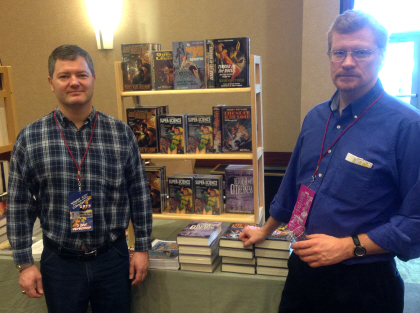
The Haffner Press table is always an impressive sight. I have most of his titles, but it’s still a joy to see them all assembled and on display.
If you’re not familiar with Stephen’s work, you need to be. He is single-handedly building one of the most important libraries of pulp and pulp-related fiction in the industry, and over the past five years he’s published some of the finest collections in the genre.
A small sample of the books he’s produced recently include four volumes of The Collected Edmond Hamilton, Henry Kuttner and C.L. Moore’s Detour to Otherness, Leigh Brackett’s Shannach — the Last: Farwell to Mars, Henry Kuttner’s Thunder in the Void and Terror in the House, Robert Silverberg’s Tales From Super-Science Fiction, and many, many others.
As long as I was standing there, I took the opportunity to purchase a copy of The Complete John Thunstone, by Manly Wade Wellman.
If that sounds familiar, it’s probably because it was the subject of one of the most successful contests we’ve ever held at Black Gate. We published the winning entries in March 2013, in “The Best One-Sentence Reviews of Manly Wade Wellman: The Winners of The Complete John Thunstone.” It’s become the template for every successful contest we’ve run since.
I’d held a number of copies of the book in my hot little hands over the last few months — including several that I’d mailed out to contest winners — and I now finally had one of my own. At last.
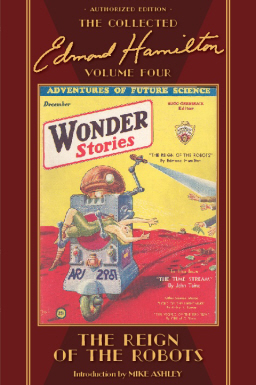 One of the many pleasures of visiting the Haffner booth is seeing the mock-ups for his upcoming titles, and I wasn’t disappointed. Stephen had several enticing new books on display, including Murder Draws a Crowd: The Collected Fredric Brown, Volume One, and the long-awaited fourth volume of The Collected Edmond Hamilton, The Reign of the Robots.
One of the many pleasures of visiting the Haffner booth is seeing the mock-ups for his upcoming titles, and I wasn’t disappointed. Stephen had several enticing new books on display, including Murder Draws a Crowd: The Collected Fredric Brown, Volume One, and the long-awaited fourth volume of The Collected Edmond Hamilton, The Reign of the Robots.
If THAT book looks familiar, it’s because we just wrapped up another reader contest for The Reign of the Robots (modeled after the John Thunstone contest, of course), “The Best One-Sentence Reviews of Edmond Hamilton.” You can read some of the best entries here.
Edmond Hamilton may well be my favorite pulp writer, and he has been since I read the chilling “The Man Who Evolved” in Before the Golden Age. As Isaac Asimov noted in that book, many of Hamilton’s most popular works — including a handful of his early novels, “Cities in the Air” (from Air Wonder Stories, 1929) and “The Universe Wreckers” (Amazing Stories, 1930) — have never been reprinted.
Stephen included both, and six other never-before-reprinted tales, in The Universe Wreckers, The Collected Edmond Hamilton, Volume Three, for which he will always have my eternal gratitude.
See the complete list of Stephen’s tantalizing current and upcoming releases here.
As enjoyable as it was to see the latest in the pipeline from Haffner, the true highlight of the evening occurred shortly after I ran into Jason Waltz, publisher of Rogue Blades Entertainment. Jason had a copy of his newest release, Writing Fantasy Heroes, for me, and it was a real delight to finally see it in print.
The contributor’s list for Writing Fantasy Heroes reads like a Who’s Who of modern fantasy: Brandon Sanderson, Orson Scott Card, Howard Andrew Jones, Steven Erikson, Glen Cook, and many others.
I’m not a contributor, but Jason did ask me to write the book blurb used on Amazon (and on the inside front cover.)
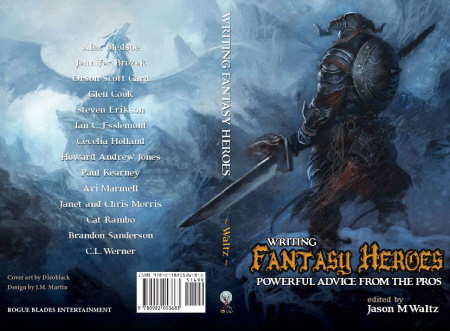 While I was cooing over the book, Jason introduced me to his friend (also named Jason), who said he’s a fan of the Black Gate blog, especially the New Treasures and Vintage Treasures series.
While I was cooing over the book, Jason introduced me to his friend (also named Jason), who said he’s a fan of the Black Gate blog, especially the New Treasures and Vintage Treasures series.
I run into fans of the magazine all the time, but it’s a little more rare to find someone who came by the blog first, so it’s always a pleasure to get feedback on what we’re doing right. I chatted with Jason the Other for a while, enjoying the chance to hear the things he most appreciated about the blog.
As the crowd was starting to thin in the Dealer’s Room, I spotted my buddy Dave Willoughby, selling pulps at Larry Hallock’s booth.
I made my way over to say hi, and very quickly got distracted by the fabulous assortment of pulps Larry had piled up on his table for sale (one of the well-known hazards of holding a conversation at Windy City).
I ended up spending twenty minutes talking to Dave and Larry as I casually looked through all their gorgeous old science fiction magazines — long enough that I eventually grew tired of holding my box. I put it on the floor.
I told you the box would come back into the story. Pay attention — I’ll come back to it in a minute.
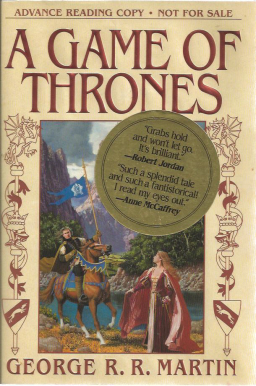
On a lark, I asked Dave what was really collectible these days. Dave has his finger on the pulse of rare book buyers in this industry better than anyone else I know, and usually has fascinating tales of high-priced book sales. Rare book buyers are a herd unto themselves, following their own collective instincts, but they have an almost unerring instinct for the next great breakout writers.
“Do you still get a lot of ARCs (Advance Review Copies)?” Dave asked.
I admitted I did. “Do you have a copy of the ARC of A Game of Thrones?” he asked. “I hear signed copies are selling for around $950.” (And indeed, a later glance at some recent eBay listings proved he was correct.)
That was interesting. I told Dave that I had in fact received a copy in 1996. At Archon 22 in St. Louis a couple of years later, I ran into George R.R. Martin during a fantastic series of readings (which I wrote about here.)
George read an excerpt from the novel for a tiny crowd of perhaps six people, and afterwards was kind enough to sign it.
However, I don’t collect ARCs (or autographs, for that matter). I had lugged A Game of Thrones to Archon to get it signed as a gift for Rodger Turner, my partner at SF Site. I gave it to him a few months later.
Dave and Larry looked suitably stricken at the thought of a book that valuable passing out of my hands so easily.
To cheer them up I asked about the Meisha Merlin hardcover edition of A Game of Thrones, a gorgeous version illustrated by Jeffrey Jones which had been published in a limited edition of 448 copies in 2001. The original cover price was $250.
“That’s almost impossible to find,” Dave said. “Last I heard copies were selling for around $2,000.”
“I ran into Stephen Pagel, publisher at Meisha Merlin, at the World Fantasy Convention in Minneapolis about ten years ago,” I said. “He offered to sell me what he said was the last copy he had in stock. I almost never buy limited editions, but I’m a sucker for a good salesman. Stephen ended up selling it to me for $175.”
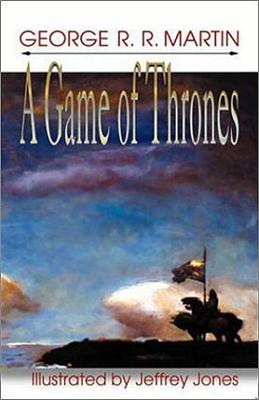
That makes A Game of Thrones the most valuable book in my collection — with the possible exception of the Donald Grant first edition of The Gunslinger, which I bought in 1982 and asked Stephen King to autograph for me in 1984.
I looked around when I got home after the show, and found this interesting article on collecting Game of Thrones first editions, including the Meisha Merlin book. It’s a few years old now, but still relevant, I think.
While I was talking to Dave and Larry, a young man came by to peruse their merchandise. I tried hard to make sure I wasn’t blocking the booth — trust me, there’s little that’s more annoying to a hard-working bookseller than a talker who stops in his booth and body-blocks interested browsers — but he seemed more interested in the goods they had on the floor. In fact, as time went by, he seemed to be growing visibly excited, and he started rooting around in a box. Without thinking I moved over to give him more room, sparing a quick glace to see what had him so interested.
Of course, it was my box. With a start I realized that the young fellow was digging through the paperbacks I’d purchased. And boy, he sure was excited. He’d pulled several out and made a pile on the floor.
He seemed very intent on buying several of my books. But after a minute I realized the thing that had him most excited was the copy of the Robert E. Howard Newsletter. He was holding that reverently, examining it with a keen eye. And if what Morgan had told me about Indy destroying the overruns was true, it was no wonder — like me, it was probably the first copy he’d ever seen.
Well, this was awkward. I’m enough of a collector myself that the thought of taking away another man’s joyous find broke my heart a little. I probably would have quietly stood by while he bought my paperbacks from Dave and Larry, and just settled accounts with them later.
But I couldn’t sell the copy of the Newsletter. Indy had given that to me as a gift. I was about to step forward and gently give him the bad news, when he put the copy down, considered the pile of paperbacks carefully, then put them back and wandered off.
Another indecisive buyer. The world is full of ’em.
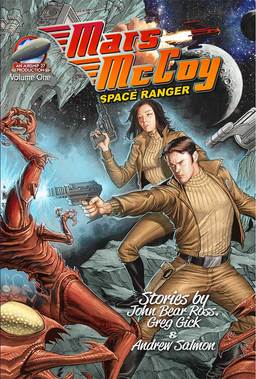 It was time to move my treasures to the car. I said my goodbyes to Dave and Larry, found my dinner companions, and headed out.
It was time to move my treasures to the car. I said my goodbyes to Dave and Larry, found my dinner companions, and headed out.
I had a very entertaining dinner that night with Jason Waltz and Matt. We talked about the big publishing news of 2013 — including the recent collapse of Night Shade Books — and the unexpected success of Jason’s latest book, Writing Fantasy Heroes. We had fun brainstorming ideas for his next one. I thought the obvious follow-ups were Writing Fantasy Villains or Writing Horror Heroes, but Jason’s plans ran in a different direction: perhaps Writing Fantasy Settings, or something similar. I thanked him again for his invitation to write the Amazon blurb for the book (which you can read here).
I did get some great stories out of him, including how he managed to gradually lure so many terrific writers — like Orson Scott Card, Glen Cook, and Steven Erikson — to contribute to Writing Fantasy Heroes. Jason said it took perseverance, and more than a little daring. He also admitted that the project took a lot more out of him than he expected. “After two years working on it, I was just fried,” he said.
I returned to the convention on Sunday. My first stop was the well-stocked Airship 27 table, heavily laden down with a fabulous selection of adventure fantasy and retro-pulp volumes, including Charles Saunders’ 1930’s tale of boxing and Nazis, Damballa, David C. Smith’s modern horror tale Call of Shadows, Riley Hogan’s Cossack epic As Tartary Burns, Jim Beard’s supernatural sleuth Sgt. Janus Spirit-Breaker and Sgt. Janus Returns, Joe Bonadonna’s new space opera Three Against the Stars, Richard Kellogg and Gary Kato’s appealing kid’s tale Barry Baskerville Solves a Case, Ron Fortier’s own masked vigilante Brother Grim, the popular anthology Tales from the Hanging Monkey, and many, many others. (Check out the Airship 27 website for a complete list of available titles.)
The booth was manned by the always charming Ron Fortier, and I was able to congratulate him on publishing such an incredible selection of adventure titles. While I agonized over which titles to try, Ron was soon deep in conversation with Bob Garcia.
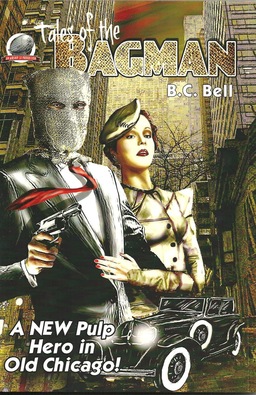 I eventually laid down my shekels for Ron’s Brother Grim and Mars McCoy, Space Ranger, and then hustled to Bill’s table to accompany him to the Sunday reading. Bill was already gone, and I realized I was late. I dashed over to the readings, and was relieved to find that they were running a little behind, and Bill hadn’t started yet. Whew!
I eventually laid down my shekels for Ron’s Brother Grim and Mars McCoy, Space Ranger, and then hustled to Bill’s table to accompany him to the Sunday reading. Bill was already gone, and I realized I was late. I dashed over to the readings, and was relieved to find that they were running a little behind, and Bill hadn’t started yet. Whew!
Bill’s reading was lightly attended, but really terrific. He read from his second Fu Manchu volume, The Destiny of Fu Manchu, and the excerpt he chose was a lot of fun.
I stuck around after Bill’s reading to hear some of the other New Pulp Sunday readers, and I was very glad I did. Several of them were fabulous. I wish I could remember them all, but several stuck in my mind — especially B.C. Bell’s Tales of the Bagman, the best of the lot.
The Bagman, a pulp action hero whose adventures take place in Old Chicago, is a ex-mob enforcer who puts a bag over his head to disguise his identity in a desperate moment, and ends up being labeled The Bagman by the tabloid Chicago press. The prose was crisp and entertaining, the action fast, and mid-30s Chicago was recreated with enough color and verisimilitude to give events just the right edge. This looks like another winner from Airship 27 — that Ron Fortier guy has a lot to be proud of!
Before the show wrapped up, I was lucky enough to stumble into the art show, and I was very glad I did. The art on display — much of it on loan from the private collections of Bob Weinberg and Doug Ellis — included many gorgeous paintings, and some of my favorite pulp cover art. I was delighted to see, for example, Robert E. Schulz’s original cover painting for Murray Leinster’s The Forgotten Planet, featuring our intrepid protagonists fighting off a giant flying wasp. I’ve loved that cover ever since I first laid eyes on it as a young teen.
As marvelous as the paperback cover is, it doesn’t do justice to the original art. I could have spent a lot longer in the Art Room — this year, I’m going early!
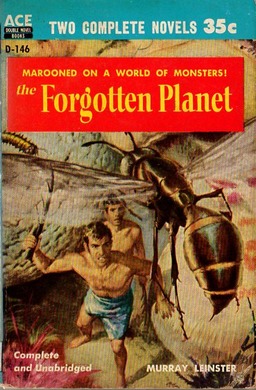
If there’s a place on Earth that rewards browsing better than Windy City Pulp and Paper, I’d love to know what it is. I found the Girasol table piled high with their usual assortment of high-quality pulp reprints — and a surprise collectible: a copy of the boxed edition of Chaosium’s Thieves World, published in 1981, in great shape. I paid $10 for it, although I didn’t mange to get away from the table without spending a great deal more on some vintage Judge Dredd collections.
I’m not sure what it is with Girasol and Chaosium. Years ago I took a beautiful set of Call of Cthulhu adventures off their hands for the criminally low price of $30 — a set which included the ultra-rare Horror on the Orient Express, a fabulous mega-adventure that is now long out-of-print and commands outrageous prices in the collector’s market. Fortunately, Horror on the Orient Express was brought back to life just last year with a successful Kickstarter campaign that promises a re-imagining of the iconic classic with high-quality components.
Over in the corner, I was passing Doug Ellis’ table when I glimpsed another eye-catching treasure: a stack of copies of Frank R. Paul: The Dean of Science Fiction Illustration, a gorgeous book showcasing the best work of perhaps the single most important SF pulp artist (my review is here).
Jerry Weist, legendary fan and collector, had died in 2011, and the book had been released posthumously in 2013. I’d wanted a copy since I’d first seen it advertised months ago, and I didn’t waste any more time. Doug sold me a copy — along with the latest issue of his magazine Pulp Vault — and in the process introduced me to Glynn Crain, the editor of the book.
Glenn and I had a great conversation. “It was Jerry Weist’s fondest wish to get this book out,” he told me. “Roger [Hill, the other editor] and I worked hard to make it happen.”
I showed off my copy as I continued to walk the floor. Before long I found myself at Gary Gianni’s table. He had a box of $2 paperbacks, and I saw copies of Robert E. Howard’s The People of the White Circle and Flashing Swords #1 peeking out at me. I have a hard enough time passing a box of $2 paperbacks as it is, and that didn’t make it any easier.
 I ended up buying those two, and a few others (and was inspired to write a long overdue post on The People of the White Circle a few days later.) While I was talking to Gary he showed me some of the art books he had for sale, including Flesk Prime, a beautiful hardcover showcasing his work along four other artists: Craig Elliott, Petar Meseldzija, Mark Schultz and William Stout.
I ended up buying those two, and a few others (and was inspired to write a long overdue post on The People of the White Circle a few days later.) While I was talking to Gary he showed me some of the art books he had for sale, including Flesk Prime, a beautiful hardcover showcasing his work along four other artists: Craig Elliott, Petar Meseldzija, Mark Schultz and William Stout.
This seemed like a great idea, and well worth supporting, and I was happy to have Gary sell me a copy.
One table over I shook hands with the talented Jim Pavelic, an artist whose work has graced several back issues of Black Gate. He had a table of his own as well, selling some striking original prints.
My wandering feet eventually took me to Greg Ketter’s booth, where I was happy to park for some time, chatting with Greg. We talked about the problems at Night Shade, and the recent influx of new small press books — “So many I can barely keep up with them,” Greg admitted.
It was obvious to me that he was making a damn good attempt. While the vast majority of dealers at Windy City devote themselves to books and magazines from decades past, Greg does a brisk business specializing in new books — the kind of specialty interest titles you just don’t see stocked at Barnes & Noble.
His table was crammed with hundreds of new releases, including a full complement of limited edition hardcovers, art books, small press collections, and odds and ends. I saw several new volumes from Centipede Press, including Speak to Me of Death: The Selected Short Fiction of Cornell Woolrich, Volume 1, and Where the Summer Ends: The Best Horror Stories of Karl Edward Wagner, Volume 1.
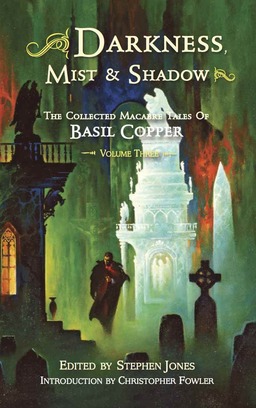 I also saw the massive, two-volume The Century’s Best Horror Fiction, edited by John Pelan — the only copies I’ve ever seen.
I also saw the massive, two-volume The Century’s Best Horror Fiction, edited by John Pelan — the only copies I’ve ever seen.
In fact, Greg frequently has books I’ve never seen before. For example, it was just a few years ago at his table at Windy City that I’d spotted the two-volume set of Darkness, Mist & Shadows: The Collected Macabre Tales of Basil Copper, with their beautiful Stephen Fabian covers. They’re now part of my collection. Where else can you find treasures like this?
Earlier Greg had been part of a lively booksellers panel, which also included Alice Bentley, Bob Weinberg, and other top SF and fantasy booksellers. There was cautious optimism that the gradual death of the large national book chains (meaning Borders and Barnes & Noble, primarily), might leave room for a new wave of niche booksellers.
I hope they’re right. But for now, I was happily content to browse Gregg’s generously overstocked tables at Windy City, picking up books I could get nowhere else.
A few booths down, Bob Weinberg was selling canceled checks from the Munsey magazines — including some made out to Harold Lamb. With Bob’s permission, I snapped a few pics to show to Howard Andrew Jones. I thought he’d get a kick out of them.
It was getting late, and the Dealer’s Room was starting to close down for another year. I hurried over to the table where Dave and Larry were still selling pulps, determined to make a deal on the magazines I had spotted yesterday. After all, you can’t come to Windy City Pulp and leave without a single pulp magazine!
And make a deal I did. They still had a fine assortment remaining from their original stock, many in great shape, and were open to offers. I eventually made an imposing pile of sixteen pulps — including Astounding, Amazing Stories, Thrilling Wonder, Science Fiction, Space Stories, and Dynamic Science Fiction. We haggled for a bit, and eventually agreed on a very satisfactory price.
Here’s a sample of three of the pulps I brought home (click on any of the images for a larger version):
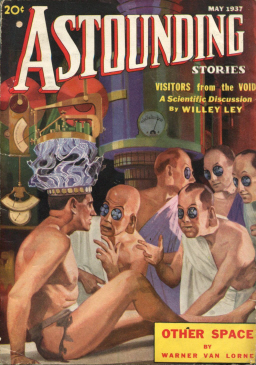 |
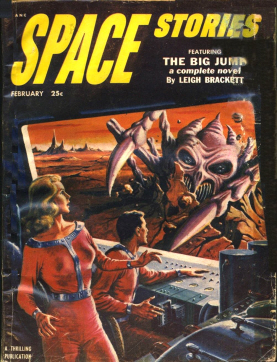 |
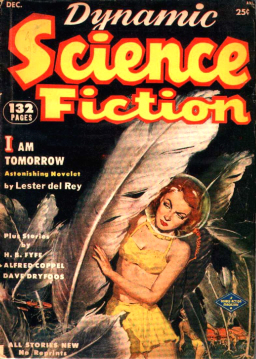 |
This brings my summary of the 2013 Windy City Pulp and Paperback convention to a close. I hope you’ve seen or heard at least a few things that piqued your interest.
If so, by all means drop by this weekend — we’d love to meet you!
The Windy City Pulp and Paper Convention will be held in Lombard, IL from Friday, April 25th through Sunday, April 27, at the Westin Lombard Yorktown Center. One day passes are $25, a 3-day membership is only $35. For more info, visit the website.
Epic post of an epic event!
Will we see you there? We’ll be there on Friday, at least.
Thanks Eric!
Arin,
Absolutely! My flight back from Las Vegas lands at around 3, but I hope to be there shortly afterwards. What about you – will you have a booth this year, or are you just shopping? 🙂
Matt and I will be there by 10:30 to spend the day browsing and buying. I’m going to try and reduce inventory too, looking to move a quantity of Rage of the Behemoth, Sages & Swords, even Writing Fantasy Heroes. Will you be appearing late in the day Saturday once again, John?
Glad to hear it, Jason! Does that mean you’ll have a booth?
I hope to make it late Friday, and most of the day Saturday this year. No D&D game to hold me up this time. 🙂
Still no booth for us….just shopping! That said, if we could find a time to meet up…I think I have a DeLint book for you.
No booth – I couldn’t commit to the whole weekend, so I couldn’t get one. I’m going to try getting one or more of those there to host or buy some of RBE’s stuff. May even just hand out RBE sportpacks with a copy of ROTB inside. Gotta move inventory no matter how hard it is 😉
[…] City Pulp and Paper, one of my favorite local cons (the write-up I did on last year’s is here). I wasn’t in the room five minutes before I heard a friendly voice calling my name: Arin […]
[…] City Pulp and Paperback Convention has wrapped up for another year (see my report from last year here). I got to see many old friends, meet some new ones, and also connect in person with a few for […]
[…] pulp vigilante novel Tales of the Bagman, which I wrote about enthusiastically in my report on last year’s show, and Jim Beard’s supernatural detective collection Sgt. Janus, Spirit-Breaker – […]
[…] Windy City Pulp and Paper is a fabulous convention and, as its name implies, it’s focused mostly on vintage magazines and paperbacks. Wandering the vast Dealer’s Room is like stepping into a Cave of Wonders for fans of pulp science fiction and fantasy. […]
[…] the hardcover edition of Damon Knight’s Science Fiction of the 30′s on a sale table at Windy City Pulp and Paper for just $3.33. Items on the table were priced at 3 for $10, so before I could buy it, I had to […]